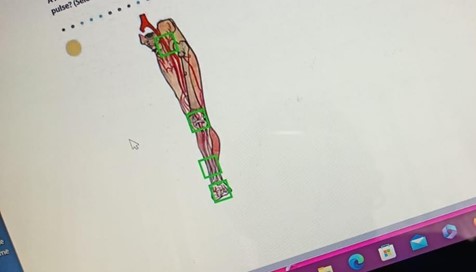A nurse is assessing a client's peripheral circulation. In which of the following locations should the nurse palpate to assess the posterior tibial pulse? (Selectable areas, or "Hot Spots," are outlined in the artwork below. Select only the outlined area that corresponds to your answer.)

inguinal canal
knee
lower third of the tibia
dorsal aspect of the foot
The Correct Answer is C
A. Inguinal canal is not the correct location for assessing the posterior tibial pulse. This area is associated with the femoral pulse.
B. The knee is not the correct location for assessing the posterior tibial pulse. This area is not directly related to the posterior tibial pulse.
C. The lower third of the tibia, anterior aspect is the correct location for palpating the posterior tibial pulse. This pulse can be found on the inside of the ankle, slightly below and behind the medial malleolus.
D. Dorsal aspect of the foot is where the dorsalis pedis pulse is located, not the posterior tibial pulse.
Nursing Test Bank
Naxlex Comprehensive Predictor Exams
Related Questions
Correct Answer is B
Explanation
A. Using a computer terminal in a non-public area is appropriate and helps maintain client confidentiality.
B. Sharing computer passwords with coworkers is a serious breach of client confidentiality and security. Each individual should have their own unique login credentials to ensure accountability and protect sensitive information.
C. Logging out of the computer before leaving a terminal is a standard practice to protect client information from unauthorized access.
D. Preventing an unidentified healthcare worker from viewing a health record on the computer screen is a responsible action to protect client confidentiality.
Correct Answer is A
Explanation
A. This statement is incorrect. While HIPAA allows for certain disclosures to family members, it is important to follow specific guidelines and obtain appropriate consent or authorization from the client when sharing their health information. There are also circumstances where a client may request that information be withheld from certain family members.
B. This statement is correct. HIPAA is a federal law that establishes privacy standards for protected health information.
C. This statement is correct. A client's address is considered personally identifiable information under HIPAA.
D. The statement appears to be cut off. However, it is important to note that HIPAA does indeed establish regulations for protecting individually identifiable health information in various forms, including verbal, electronic, and written.
Whether you are a student looking to ace your exams or a practicing nurse seeking to enhance your expertise , our nursing education contents will empower you with the confidence and competence to make a difference in the lives of patients and become a respected leader in the healthcare field.
Visit Naxlex, invest in your future and unlock endless possibilities with our unparalleled nursing education contents today
Report Wrong Answer on the Current Question
Do you disagree with the answer? If yes, what is your expected answer? Explain.
Kindly be descriptive with the issue you are facing.
